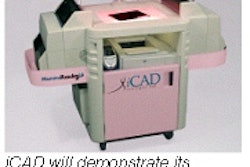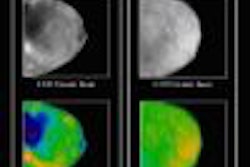CHICAGO - The three FDA-approved computer-aided detection (CAD) software programs designed to help radiologists read mammograms all do a decent job, researchers said at this week's RSNA meeting.
“The good news is that all three of these programs do a pretty good job and they are all about the same in their performance,” said Dr. Michael Nelson, associate professor of radiology at the University of Minnesota Medical School, Minneapolis.
Nelson and colleagues performed an independent series of tests on the programs. The only support given to the researchers, he said, was that the companies donated their mammogram reading systems for use in the trial.
The dataset included 120 breast cancer cases with 128 biopsy-proven cancers. There were 113 cases that held a single cancer; six cases had two cancers; and one case included three cancers. The cases were culled from 3,000 breast cancer cases and excluded patients with family history of cancer or previous biopsies.
Nelson said that ImageChecker, manufactured by R2 Technology of Sunnyvale, CA, identified cancer in 109 of the 120 cases, 90.8%; MammoReader, developed by iCAD of Boca Raton, FL, identified cancer in 108 of 120 cases for a success rate of 90%; and Second Look, produced by CADx Systems of Beavercreek, OH, found cancers in 107 of the 120 cases, a success rate of 89.2%.
Nelson did find some differences when he looked at cancer region level sensitivity. He defined cancer region level sensitivity as the percentage of cancer regions detected in every view where it is visible, and the systems checked three different views. Mammographers identified 248 regions.
The Image Checker reported cancer in 200 of the 248 regions or 80.7%; the MammoReader saw lesions in 201 of 248 regions or 81%; the Second Look system located cancer in 180 of 248 regions or 72.6%.
“Computer-assisted diagnosis does help our practice in detecting breast cancer,” Nelson said.
That was the similar conclusion of Dr. Stamatia Destounis, a radiologist at the Elizabeth Wende Breast Clinic in Rochester, NY, who reported on a study in which researchers tried to determine if adding CAD as a second reader of mammograms resulted in more frequent recalls of patients undergoing mammography screening. The clinic has screened 19,586 women since November 2000, and discovered 90 cancers, 70% of which were invasive growths.
Destounis, in her study, found that an additional 2% of patients were recalled for another look at their films by computer program prompts, but the system increased the cancer detection rate by 7%. And when those prompts turned out to be for missed lesions, “all the prompts made by the computer were for invasive cancers.” She said that “if we had listened to the computer we would have located more cancers.”
She said that in the study protocol each radiologist had stated her opinion, and then utilized the CAD program, which occasionally has resulted in an added patient recall. Recalls were recorded as physician-prompted, with or without CAD agreement, or CAD-prompted. The CAD could prompt a recall, but not cancel a recall.
Overall, the computer system proved to have a 77% accuracy in her study. She said the systems were accurate -- in the 95% range -- in identifying calcifications.
“Our study showed that computer-aided diagnosis has the potential to increase the detection of breast cancer," Destounis concluded.
By Edward Susman
AuntMinnie.com
contributing writer
December
6, 2002
Copyright © 2002 AuntMinnie.com



















